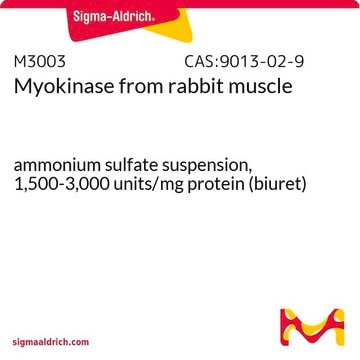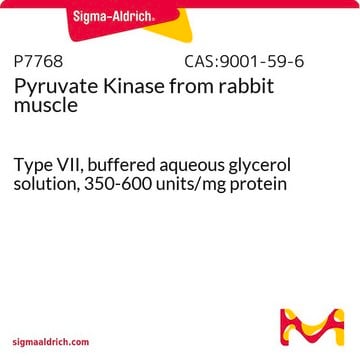P4390
Polynucleotide Kinase from T4-infected Escherichia coli
10 units/μL, buffered aqueous glycerol solution
Sign Into View Organizational & Contract Pricing
All Photos(1)
About This Item
CAS Number:
MDL number:
UNSPSC Code:
12352204
NACRES:
NA.53
Recommended Products
grade
for molecular biology
form
buffered aqueous glycerol solution
mol wt
33 kDa
concentration
10 units/μL
foreign activity
Endonuclease and exonuclease, none detected
shipped in
wet ice
storage temp.
−20°C
Looking for similar products? Visit Product Comparison Guide
Application
Suitable for:
- Sequencing or nucleic acid tagging (DNA and RNA) by 5′-end labeling
- 5′ phosphorylation of oligonucleotides
- Removal of 3′-phosphate groups from phosphorylpolynucleotides
Components
T4 Polynucleotide Kinase is supplied in a solution of 50% glycerol (v/v), 20 mM Tris-HCl (pH 7.5), 25 mM KCl, 2mM DTT, 0.1 mM EDTA, and 0.1 μM ATP.
Principle
Polynucleotide kinase catalyses a "forward reaction" transfer of the γ-phosphate of ATP to the 5′ hydroxyl terminus of single- and double-stranded nucleic acids (DNA and RNA) and 3′-nucleoside monophosphates. In exchange reactions containing ADP, the enzyme will catalyze the exchange of 5′-terminal phosphate groups and ATP. The 3′-phosphatase activity enables the enzyme to remove 3′-phosphoryl groups from phosphorylpolynucleotides.
1. Forward reaction: Transfer of the labeled γ-phosphate from [γ-32P]-ATP to the free 5′-hydroxyl group of the substrate.
5′-HO-DNA + [γ-32P]-ATP → 5′-32PO-DNA + ADP.
Substrates that do not have a free 5′-hydroxyl require prior dephosphorylation by alkaline phosphatase.
2. Exchange reaction: First, the terminal 5′-phosphate is transferred from the substrate to ADP present in the reaction mixture. Then, the labeled γ-phosphate from [γ-32P]-ATP is transferred to the free hydroxyl group of the substrate.
5′-PO-DNA + ADP → 5′-HO-DNA + ATP
5′-HO-DNA + [γ-32P]-ATP → 5′-32PO-DNA + ADP
1. Forward reaction: Transfer of the labeled γ-phosphate from [γ-32P]-ATP to the free 5′-hydroxyl group of the substrate.
5′-HO-DNA + [γ-32P]-ATP → 5′-32PO-DNA + ADP.
Substrates that do not have a free 5′-hydroxyl require prior dephosphorylation by alkaline phosphatase.
2. Exchange reaction: First, the terminal 5′-phosphate is transferred from the substrate to ADP present in the reaction mixture. Then, the labeled γ-phosphate from [γ-32P]-ATP is transferred to the free hydroxyl group of the substrate.
5′-PO-DNA + ADP → 5′-HO-DNA + ATP
5′-HO-DNA + [γ-32P]-ATP → 5′-32PO-DNA + ADP
Unit Definition
One unit catalyzes the transfer of one nanomole of 32P to the 5′-end of micrococcal nuclease-treated DNA in 30 min. at 37 °C. Transfer is detected as incorporation into acid-insoluble material.
Analysis Note
Activity is determined in a reaction mixture containing 40 mM Tris-HCl (pH 7.5), with 10 mM MgCl2, 5 mM dithiothreitol, 0.5 mM 5′-OH polynucleotide ends, and mM [γ-32P]-ATP.
related product
Product No.
Description
Pricing
Glutathione S-Transferase from E. coli, recombinant, expressed in E. coli, buffered aqueous solution
Ribonuclease A from bovine pancreas, for molecular biology, ≥70 Kunitz units/mg protein, lyophilized
Signal Word
Danger
Hazard Statements
Precautionary Statements
Hazard Classifications
Resp. Sens. 1
Storage Class Code
10 - Combustible liquids
WGK
WGK 3
Flash Point(F)
Not applicable
Flash Point(C)
Not applicable
Personal Protective Equipment
dust mask type N95 (US), Eyeshields, Gloves
Certificates of Analysis (COA)
Search for Certificates of Analysis (COA) by entering the products Lot/Batch Number. Lot and Batch Numbers can be found on a product’s label following the words ‘Lot’ or ‘Batch’.
Already Own This Product?
Find documentation for the products that you have recently purchased in the Document Library.
Audun Hanssen-Bauer et al.
Environmental and molecular mutagenesis, 52(8), 623-635 (2011-07-26)
XRCC1 is a scaffold protein capable of interacting with several DNA repair proteins. Here we provide evidence for the presence of XRCC1 in different complexes of sizes from 200 to 1500 kDa, and we show that immunoprecipitates using XRCC1 as
Nigel J Jones
Methods in molecular biology (Clifton, N.J.), 817, 183-206 (2011-12-08)
32P-postlabelling is a technique originally described by Kurt Randerath and colleagues for the sensitive detection of damage produced in DNA by reactive chemicals or genotoxins. The procedure essentially entails the enzymatic digestion of DNA to nucleoside 3'-monophosphates which are then
Eduardo Paredes et al.
Methods (San Diego, Calif.), 54(2), 251-259 (2011-03-01)
Advances in RNA nanotechnology will depend on the ability to manipulate, probe the structure and engineer the function of RNA with high precision. This article reviews current abilities to incorporate site-specific labels or to conjugate other useful molecules to RNA
A role in true-late gene expression for the T4 bacteriophage 5' polynucleotide kinase 3' phosphatase.
K Sirotkin et al.
Journal of molecular biology, 123(2), 221-233 (1978-08-05)
Priscilla Braglia et al.
EMBO reports, 11(10), 758-764 (2010-09-04)
Transcription termination by RNA polymerase I in Saccharomyces cerevisiae is mediated by a 'torpedo' mechanism: co-transcriptional RNA cleavage by Rnt1 at the ribosomal DNA 3'-region generates a 5'-end that is recognized by the 5'-3' exonuclease Rat1; this degrades the downstream
Our team of scientists has experience in all areas of research including Life Science, Material Science, Chemical Synthesis, Chromatography, Analytical and many others.
Contact Technical Service







